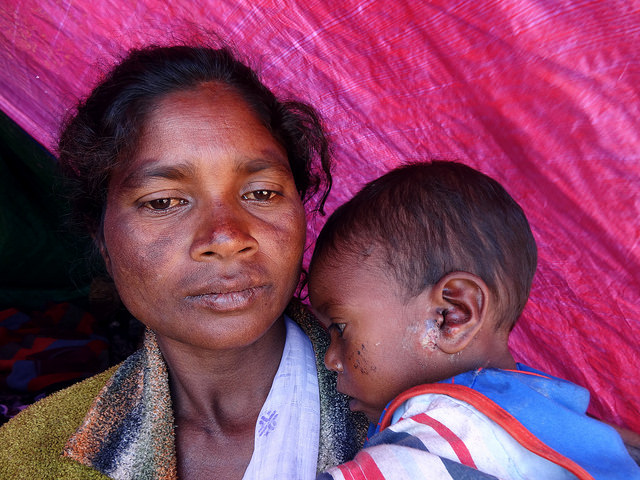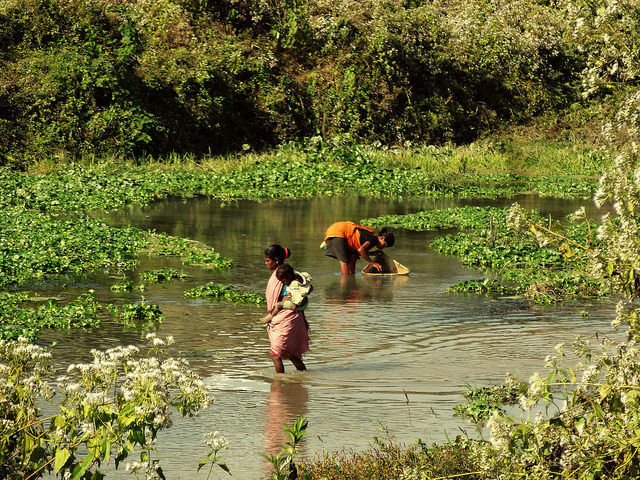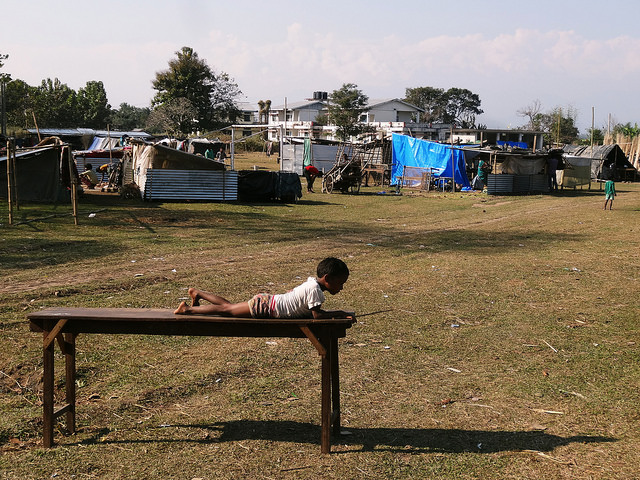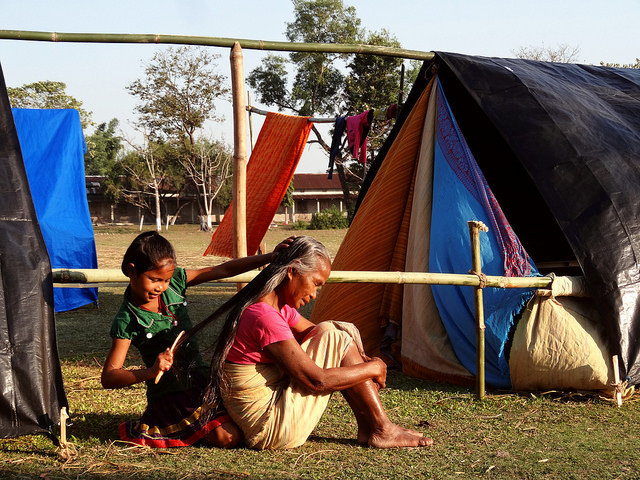
In Serfanguri relief camp in Kokrajhar, several tents were erected, but they were inadequate to properly house the roughly 2,000 people who had arrived there on Dec. 23, 2014. This single tent houses 25 women and children. Credit: Priyanka Borpujari/IPS
KOKRAJHAR, India, Jan 29 2015 (IPS) – The tarpaulin sheet, when stretched and tied to bamboo poles, is about the length and breadth of a large SUV. Yet, about 25 women and children have been sleeping beneath these makeshift shelters at several relief camps across Kokrajhar, a district in the north-eastern Indian state of Assam.
The inhabitants of these camps – about 240,000 of them across three other districts of Assam – fled from their homes after 81 people were killed in what now seems like a well-planned attack.
The Asian Centre for Human Rights says the situation is reaching a , representing one of the largest conflict-related waves of displacement in India.
It has turned a mirror on India’s inability to meet the Millennium Development Goals (MDGs), and suggests that continued violence across the country will pose a major challenge to meeting the basic development needs of a massive population.

Hunger is constant in the refugee camps, with meagre rations of rice, lentils, cooking oil and salt falling short of most families’ basic needs. Women are forced to walk long distances to fetch firewood for woodstoves. Credit: Priyanka Borpujari/IPS
Appalling conditions
On the evening of Dec. 23, several villages inhabited by the Adivasi community were allegedly attacked by the armed Songbijit faction of the National Democratic Front of Bodoland (NDFB), which has been seeking an independent state for the Bodo people in Assam.
The attacks took place in areas already marked out as Bodoland Territorial Authority Districts (BTAD), governed by the Bodoland Territorial Council (BTC).
But the Adivasi community that resides here comprises several indigenous groups who came to Assam from central India, back in 150 AD, while hundreds were also forcibly brought to the state by the British to work in tea gardens.
Clashes between the Adivasi and Bodo communities in 1996 and 1998 – during which an estimated 100 to 200 people were killed – still bring up nightmares for those who survived.

This child, a resident of the Serfanguri camp, is suffering from a skin infection. His mother says they are yet to receive medicines from the National Rural Health Mission (NRHM). Credit: Priyanka Borpujari/IPS
It explains why the majority of those displaced and taking shelter in some 118 camps are unwilling to return to their homes.
But while the tent cities might seem like a safer option in the short term, conditions here are deplorable, and the government is keen to relocate the temporary refugees to a more permanent location soon.
The relief camp set up at Serfanguri village in Kokrajhar lacks all basic water and sanitation facilities deemed necessary for survival. A single tent in such a camp houses 25 women and children.
“The men sleep in another tent, or stay awake at night in turns, to guard us. It is only because of the cold that we somehow manage to pull through the night in such a crowded space,” explains Maino Soren from Ulghutu village, where four houses were burned to the ground, forcing residents to run for their lives carrying whatever they could on their backs.
Now, she tells IPS, there is a serious lack of basic necessities like blankets to help them weather the winter.
Missing MDG targets
In a country that is home to 1.2 billion people, accounting for 17 percent of the world’s population, recurring violence and subsequent displacement put a huge strain on limited state resources.
Time after time both the local and the central government find themselves confronted with refugee populations that point to gaping holes in the country’s development track record.

With food in limited supply and fish being a staple part of the Assamese diet, it is common to see women and even children fishing in the marshy swamps that line the edge of the refugee camps, no matter how muddy or dirty the water might be. Credit: Priyanka Borpujari/IPS
Outside their hastily erected tents in Kokrajhar, underweight and visibly undernourished children trade biscuits for balls of ‘jaggery’ (palm sugar) and rice.
Girls as young as seven years old carry pots of water on their heads from tube wells to their camps, staggering under the weight of the containers. Others lend a hand to their mothers washing pots and pans.
Related IPS Articles
The scenes testify to India’s stunted progress towards meeting the MDGs, a set of poverty eradication targets set by the United Nations, whose timeframe expires this year.
One of the goals – that India would reduce its portion of underweight children to 26 percent by 2015 – is unlikely to be reached. The most recent available data, gathered in 2005-2006, found the number of underweight children to be 40 percent of the child population.
Similarly, while the District Information System on Education (DISE) data shows that the country has achieved nearly 100 percent primary education for children aged six to ten years, events like the ones in Assam prevent children from continuing education, even if they might be enrolled in schools.
According to Anjuman Ara Begum, a social activist who has studied conditions in relief camps all across the country and contributed to reports by the Internal Displacement Monitoring Centre (IDMC), “Children from relief camps are allowed to take new admission into nearby public schools, but there is no provision to feed the extra mouths during the mid-day meals. So children drop out from schools altogether and their education is impacted.”
Furthermore, in the Balagaon and Jolaisuri villages, where camps have been set up to provide relief to Adivasi and Bodo people respectively, there were reports of the deaths of a few infants upon arrival.
Most people attributed their deaths to the cold, but it was clear upon visiting the camps that no special nutritional care for lactating mothers and pregnant women was available.

This little boy is one of hundreds whose schooling has been interrupted due to violence. The local administration is attempting to evict refugees from the camps, most of which are housed in school compounds, but little is being done to ensure the educational rights of displaced children. Credit: Priyanka Borpujari/IPS
Bleak forecast for maternal and child health
Such a scenario is not specific to Assam. All over India, violence and conflict seriously compromise maternal and child health, issues that are high on the agenda of the MDGs.
In central and eastern India alone, some 22 million women reside in conflict-prone areas, where access to health facilities is compounded by the presence of armed groups and security personnel.
This is turn complicates India’s efforts to reduce the maternal mortality ratio from 230 deaths per 100,000 live births to its target of 100 deaths per 100,000 births.
It also means that India is likely to miss the target of lowering the infant mortality rate (IMR) by 13 points, and the under-five mortality rate by five points by 2015.

Scenes like this are not uncommon at relief camps inhabited by the Bodo community. Many families have accepted that they will have a long wait before returning to their homes, or before their children resume schooling. Credit: Priyanka Borpujari/IPS
According to a recent report by Save the Children, ‘’, India is one of the worst performers in South Asia, reporting the world’s highest number of under-five deaths in 2012, and counting some 1.4 million deaths of under-five children.
Nutrition plays a major role in the mortality rate, a fact that gets thrown into high relief at times of violence and displacement.
IDPs from the latest wave of conflict in Assam are struggling to make do with the minimal provisions offered to them by the state.
“While only rice, lentils, cooking oil and salt are provided, there is no provision for firewood or utensils, and hence the burden of keeping the family alive falls on the woman,” says Begum, adding that women often face multiple hurdles in situations of displacement.
With an average of just four small structures with black tarpaulin sheets erected as toilets in the periphery of relief camps that house hundreds of people, the basic act of relieving oneself becomes a matter of great concern for the women.
“Men can go anywhere, any time, with just a mug of water. But for us women, it means that we have to plan ahead when we have to relieve ourselves,” said one woman at a camp in Lalachor village.
It is a microcosmic reflection of the troubles faced by 636 million people across India who lack access to toilets, despite numerous commitments on paper to improve the sanitation situation in the country.
As the international community moves towards an era of sustainable development, India will need to lay plans for tackling ethnic violence that threatens to destabilize its hard-won development gains.
Edited by